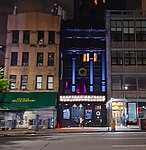Samuel J. Friedman Theatre

The Samuel J. Friedman Theatre, formerly the Biltmore Theatre, is a Broadway theater at 261 West 47th Street in the Theater District of Midtown Manhattan in New York City. Opened in 1925, it was designed by Herbert J. Krapp in the neo-Renaissance style and was constructed for Irwin Chanin. It has 650 seats across two levels and is operated by the Manhattan Theatre Club (MTC). The auditorium interior is a New York City landmark, and the theater is listed on the National Register of Historic Places. Since 2008, the theater has been named for Broadway publicist Samuel J. Friedman, whose family was a major donor to MTC. The facade is largely designed in terracotta and buff-colored brick. The ground floor, which contains the theater's entrance, is shielded by a marquee. The upper stories are divided into bays separated by fluted pilasters, and the facade is topped by an entablature and balustrade. The auditorium contains neo-Renaissance detailing, a raked orchestra level, a large balcony, and a shallow domed ceiling. The basement contains MTC's gift shop and the Susan and Peter J. Solomon Family Lounge, while a mezzanine level contains another lounge. There are also false box seats near the front of the auditorium, flanking the proscenium arch. The modern configuration of the theater dates to a 2000s renovation, when the auditorium was redesigned to a smaller size, allowing the addition of MTC's lounges and offices behind it. The Biltmore Theatre was Chanin's second Broadway theater, opening on December 7, 1925, with the play Easy Come Easy Go. The Biltmore largely hosted flops during the late 1920s and early 1930s. It was used by Federal Theatre's Living Newspaper project in 1936 before being acquired by Warner Bros. The Biltmore was a CBS radio and television studio from 1952 to 1961, when producer David Cogan turned the Biltmore back into a legitimate theater. Cogan sold the Biltmore in 1986, and it fell into disrepair after a fire in late 1987. Though the theater was sold several times afterward, including to the Nederlander Organization and Stewart F. Lane in 1993, it was not restored until MTC agreed to operate the theater in 2001. The theater reopened in 2003, and MTC took ownership of the Friedman after it was renamed in 2008.
Excerpt from the Wikipedia article Samuel J. Friedman Theatre (License: CC BY-SA 3.0, Authors, Images).Samuel J. Friedman Theatre
West 47th Street, New York Manhattan
Geographical coordinates (GPS) Address External links Nearby Places Show on map
Geographical coordinates (GPS)
| Latitude | Longitude |
|---|---|
| N 40.7603 ° | E -73.9868 ° |
Address
Samuel J. Friedman Theatre
West 47th Street 261
10036 New York, Manhattan
New York, United States
Open on Google Maps











